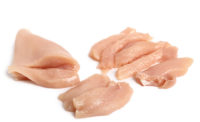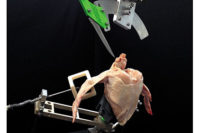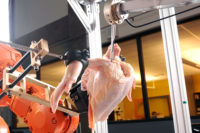Small changes matter to production lines — and the bottom line.
“A one percent increase in product yield translates to approximately $1.5 million in increased revenue for a given poultry plant,” says Ai-Ping Hu, Ph.D., senior research engineer, Georgia Tech Research Institute, in Atlanta.
Poultry, pork and beef processors are experimenting today with more automation and robotics in cutting and deboning operations, which will, they hope, lead to increased speed, efficiencies, worker safety and food safety.
Cutting and deboning equipment that can disassemble the entire bird is available.
“Historically, processors hand deboned birds, which resulted in a higher yield than using automated equipment,” says Tim Scanlan, vice president of operations at Butterball, in Garner, N.C. “It is difficult to maintain a skilled workforce specialized in deboning, however, so automation has become increasingly important.”
The expectation when selecting automated equipment is to achieve the same yield or very close to the same yield as obtained when hand deboning.
“Luckily, equipment that will achieve this desired result is available today,” says Scanlan.
One challenge with automated deboning equipment, Scanlan notes, is achieving acceptable yields because bird sizes vary.
“The second challenge is the high cost of maintenance to keep the equipment performing at an acceptable level,” says Scanlan. “That said, both of these challenges are being addressed by equipment companies.”
The Georgia Tech Research Institute (GTRI), for example, has been modifying its robotic arm cutter, the Intelligent Deboning System, to debone chickens quicker and more accurately. For the past several years, the GTRI team has experimented with essentially adding a knife to a robotic arm to debone birds from the shoulders (cut in at the collarbone, over to the shoulder, cut through the shoulder joint and down the shoulder blade). The robot uses a 3D camera to first take pictures of the bird to see where the bones are located. Then, the robot can customize its cut within 3 millimeters of accuracy to best debone it.
“We are trying to improve our line speed from 10 birds a minute to the customary 45 birds a minute,” Hu says. “However, we are slowly improving and already matching the same yields as people cutters.”
Hu says the poultry industry is interested in his team’s robotic arm to address the ever-present problem of high employee turnover, which isn’t too surprising as cutters and deboners have one of the hardest jobs in the country and require intensive training.
“Also, a robot can cut its first bird on shift as well as its last bird,” he says. “Cutting birds for eight hours is exhausting for workers.”
While automatic deboning machines are being used in the industry, Hu notes these machines aren’t as accurate as workers, because they don’t customize their cuts.
“The robot mimics a human arm,” he says. “Fixed automatic machines are limited in their cuts. They can make small adjustments but are not as versatile as a robotic arm.”
Automating boneless beef
A new Baird, Texas, custom beef processing facility — NSC Beef Processing, LLC — currently under construction proposes to use only a pneumatic carcass holder and maneuvering apparatus, the ButcherMaster Beef Processor, for its grass-fed beef.
According to the company, this is the first plant to not cut the spinal cord during processing. The ButcherMaster is able to process the beef without exposing the spinal cord, which leads to a boneless product with no remaining bone meal residue or potential exposure to BSE (bovine spongiform encephalopathy) from the spinal cord.
“The reason why processors break the carcass apart is because it’s so big, but sawing through the bone creates a mess and gives you some bone residue,” says Gary Hendrix, inventor of the ButcherMaster and managing member of NSC Beef Processing. “If you never knock over the mop bucket, you never have to clean up the water, for example.”
The machine works by holding the carcass from the inside with pneumatic compression so an employee can maneuver the beef into a more workable position or height for the cutter, lessening back pressure and injury. It can also be used in an overhead position to go down the production line, be engineered for the hog industry and be streamlined and engineered to handle hot beef.
The machine also eliminates the need for the dangerous splitting saw, increases production 25 percent to 30 percent and uses less space. Labor costs may also be reduced by as much as 25 percent due to its ergonomical features, says Hendrix.
“In the long run, automation will help with insurance because meat is one of the top five industries to have work-related injuries,” says Hendrix.
Customizing the right approach
Value or lower-grade lines lend themselves to laser cutting because they allow for more uniformity, says Chris Fuller, butcher and owner of Fuller Consulting, LLC, Los Angeles.
“If selling a premium product — high-dollar product — then cut by hand, because in general machinery prohibits the best yields due to their uniformity,” he says. “The machine doesn’t have the ability to understand the best way to increase yields.”
Pork is also well suited to mechanical cutters because pork carcasses are easier to handle and less intricate, so they demand fewer and straighter line cuts, Fuller says.
“With beef, there’s a lot more singling out of muscles and separating muscle groups so it lends itself to hand cutting,” Fuller says.
Cleaning and sanitizing cutting machines also takes more worker skill than cleaning knives. “It’s better to cut a finger with a knife than cut an arm with a machine,” Fuller says.
Plants, whether they process poultry, pork or beef, have small margins to contend with, so it can be difficult to invest in new technologies.
“Processors are open to trying new equipment, but they perceive it to be expensive,” Fuller says. “Their mentality is to make their equipment work as long as it can. They will upgrade their workforce before they make big capital investments.” NP








